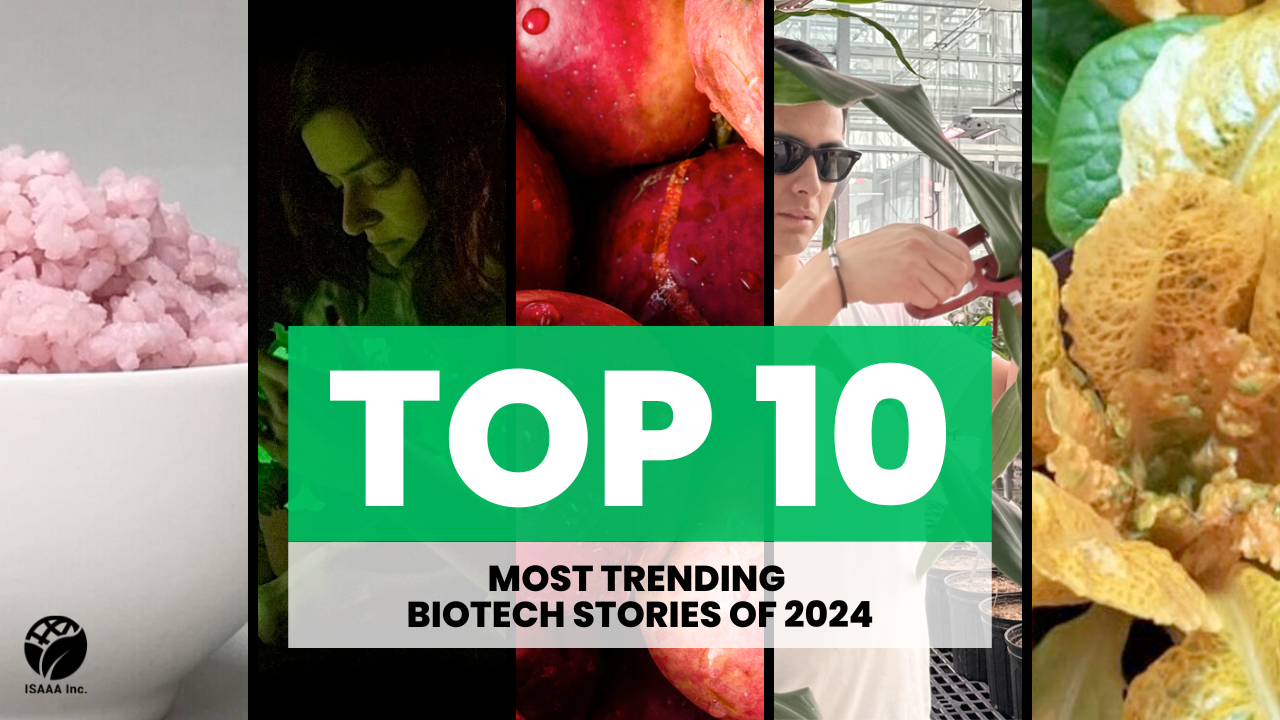Biotech Breakthroughs of 2024
| |
Reduced browning bananas for less waste, rice with beef in grains, and glowing petunia to light up homes—these are just some of the most interesting news on biotechnology in 2024. Which of these stories captured the interest of most readers?
This article summarizes the most trending stories published in Biotech Updates based on social media reach. This list also provides a glimpse of biotech happenings in the past year. Read on and check out which news made it to the top spot.

10 Scientific Breakthroughs: New Products of Biotechnology for Consumers
Since the first year of commercial planting of biotech crops in 1996, more than 70 countries have planted or imported biotech crops. These biotech crops were developed to address farmers' concerns such as increased yield, insect resistance, and herbicide tolerance. Three decades later, scientists are now focusing on developing new products for consumers. These include purple tomatoes from Norfolk Healthy Produce; Piggy Sooy, soybeans with high levels of pork protein; rice with animal muscle and fat cells within the grains; rice that grows in the ocean; and a bioluminescent glowing Firefly Petunia. In addition to these products are GM banana, biofortified rice, bioengineered Pothos, golden lettuce, and the first banana resistant to Fusarium Tropical Race 4 and Black Sigatoka disease.
9 Scientists Use CRISPR to Enhance Aroma Quality of Apple
Researchers from Shandong Agricultural University in China used gene editing techniques to modify the fatty acid-derived volatile content and salt stress tolerance of apples. The research team overexpressed an abiotic stress gene MdASG1 to increase the production of volatile aroma compounds in apples, which resulted in a more salt-stress tolerant fruit compared to the control group. The findings indicate that MdASG1 plays a vital role in increasing the accumulation of aroma compounds, especially under moderate salt stress conditions.
8 Researchers Develop Biofortified Golden Lettuce with 30 Times More Beta Carotene
A research team from the Research Institute for Plant Molecular and Cellular Biology (IBMCP) has developed an innovative method for the biofortification of leaves and other green plant tissues with increased healthy substances such as beta-carotene, the main precursor of vitamin A in the human diet. Using tobacco plants as a laboratory model and lettuce as a cultivation model, the team managed to increase the beta-carotene content in the leaves without negatively affecting other key processes such as photosynthesis. According to the researchers, the discovery that beta-carotene can be produced and stored at very high levels in a more bioaccessible form outside the places where it is usually found in leaves 'represents a very significant advance for improving nutrition through biofortification of vegetables such as lettuce, chard or spinach without giving up their characteristic scent and flavor.
7 Philippines Clears Gene-edited Bananas Developed to Reduce Food Waste
Banana varieties with improved reduced-browning characteristics have been determined as non-genetically modified organisms (GMOs) in the Philippines. The Certificates of Non-Coverage from JDC No. 01 s. 2021 was granted by the Department of Agriculture – Bureau of Plant Industry (BPI) on June 21, 2024. The reduced browning bananas (TRB011001 and TRB011002) were developed by Tropic Biosciences using the CRISPR-Cas9 gene editing system. These bananas have the potential to reduce food waste and CO2 emissions equivalent to removing 2 million cars from the road per year.
6 University of Nebraska–Lincoln Team Develops Technique to Speed Up Corn Gene Identification
A research team at the University of Nebraska–Lincoln (UNL) has taken a major step forward in identifying the function of corn genes. They developed and tested a technique that uses RNA rather than DNA, an innovative approach that identified about 10 times as many corn genes affecting flowering time than widely used DNA-based methods for identifying genes. The research team measured the RNA levels of more than 39,000 corn genes in each of roughly 700 varieties of corn, using plants grown at the university's Havelock Farm in Lincoln. They then combined the RNA measurements with those of the corn plants themselves collected both in Lincoln and by collaborators at Michigan State University. This resulted in UNL producing the largest data set of corn gene expression measurements in the world.
5 Bioluminescent Petunias to Enter the US Market for the First Time
Consumers in the United States can now purchase and grow the genetically engineered Firefly Petunias in their gardens and homes. According to the U.S. Department of Agriculture's Animal and Plant Health Inspection Service (APHIS), this modified petunia is unlikely to pose an increased plant pest risk than other produced petunias. Light Bio announced that their plants achieved brighter bioluminescence, and will glow brighter if the plants are kept healthy.
4 Shortage of Skilled Plant Breeders Could Lead to Dire Implications for Global Food Security
A research conducted across three continents by the Commonwealth Scientific and Industrial Research Organization (CSIRO) in Australia, Lincoln University in New Zealand, and McGill University in Canada found that a lack of scientists specialized in plant breeding could lead to ‘dire’ food security implications in Australia, and around the world. The joint paper paints a concerning picture of future capacity in the plant breeding area. Lead author and CSIRO scientist Dr. Lucy Egan said the shortage has been building for some time and has the potential to impact agricultural production worldwide. He emphasized that a whole generation of highly-skilled plant breeding specialists are now reaching retirement age, with a gap left as university graduates opt to focus on other areas of plant science including molecular biology.
3 CRISPR Improves Resistance to Bacterial Blight in Rice
One of the major threats in rice production is bacterial blight caused by Xanthomonas oryzae pathovar oryzae (Xoo). Developing rice varieties with resistance to bacterial blight is vital in advancing rice breeding programs and providing support to smallholder farmers. Thus, scientists from the University of Missouri and Nanjing Agricultural University have identified a key factor in Xoo's ability to infect rice: a protein called transcription activator-like effectors (TALes). TALes target specific genes in rice, including SWEET14, which is essential for the plant's health. They used CRISPR-Cas9 to edit the SWEET14 gene in rice plants and enhance resistance to bacterial blight.
2 Researchers Use CRISPR-Cas9 to Alter Photosynthesis for the First Time
A team from the University of California, Berkeley's (UCB) Innovative Genomics Institute (IGI) has produced an increase in gene expression in a food crop by changing its upstream regulatory DNA. Other studies used CRISPR-Cas9 gene editing to knock out or decrease gene expression, this new research however, is the first unbiased gene editing approach to increase gene expression and downstream photosynthetic activity. The work was pursued by the Niyogi Lab in the IGI as part of Realizing Increased Photosynthetic Efficiency (RIPE), an international research project led by the University of Illinois that aims to increase global food production by developing food crops that turn the sun's energy into food more efficiently.
1 Scientists Grow Meat Inside Rice Grains
Scientists from Yonsei University developed cultured beef rice, rice grains with animal muscle and fat cells inside. The findings of their study, published in Matter, show that cultured beef rice has 8% more protein and 7% more fat than regular rice. This breakthrough could significantly contribute to the reduction of carbon footprint in food production. Sohyeon Park, the first author of the study, said that grain-based hybrid food has the potential to provide food to address famine, contribute to military ration, or even development of more space food. (This article reached 126,205 individuals and shared 504x on Facebook.)
Subscribe to Biotech Updates to receive a summary of world developments in biotechnology every week for free. It also comes with a bimonthly Gene Editing Supplement and Science Speaks blog. Existing subscribers are encouraged to send feedback to help us improve the newsletter.
| Newer Post | Archive | Older Post |
Science Speaks is ISAAA Inc.'s official blog. Weekly blog articles, authored by ISAAA writers, partners, and invited contributors, aim to help share, disseminate, and promote scientific knowledge and its vital role in achieving global agricultural sustainability and development. Your support to Science Speaks will help us achieve this goal. You can help us by donating as little as $10.

